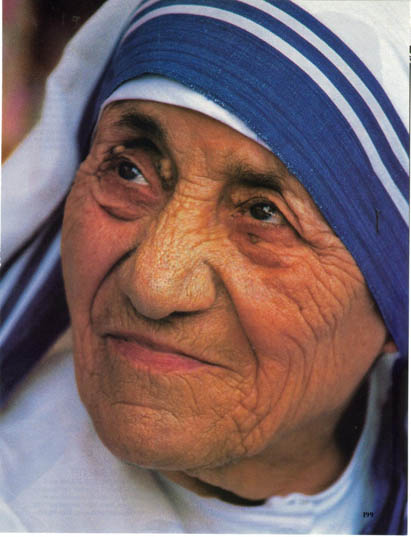The often lackadaisical coverage of Mother Teresa’s death, coming as it did in the middle of funeral preparations at Westminster, was remarkable even in an age noted for its celebrity worship. Tom Brokaw’s comment was but one example of many. Mark Harris wrote trenchantly (and accurately) in Entertainment Weekly (9/19), “…when news broke of Mother Teresa’s passing, all of television paused for the approximate length of a sigh before getting back on the gravy train.” On the day of Mother Teresa’s funeral, The New York Times featured a minuscule front-page story on the event above a much larger column announcing: “Diana’s Death Resonates Most Among Women in Therapy.” Oh.
 The striking contrasts between the coverage of the Princess and the saint were difficult to miss. Like many papers, The New York Times ran acres of worshipful articles about the Princess of Wales in the days leading up to her funeral. All well and good. But that same paper’s coverage of Mother Teresa’s life had an entirely different edge. Usually buried in the middle of the first section, articles about the Saint of the Gutters invariably mentioned her “sometimes controversial” teachings (presumably her pro-life stand, not the Gospels). Also inserted were snipings from one Indian journalist (whom The Times must have struggled mightily to find) that Mother Teresa had used the poor of Calcutta to–get this–advance her career. Somehow, though, Princess Diana’s death insulated her from this type of criticism. Even Diana’s friends would have admitted that she cannily used the media to her own advantage, though it was apparently deemed insensitive to mention this before her funeral.
The striking contrasts between the coverage of the Princess and the saint were difficult to miss. Like many papers, The New York Times ran acres of worshipful articles about the Princess of Wales in the days leading up to her funeral. All well and good. But that same paper’s coverage of Mother Teresa’s life had an entirely different edge. Usually buried in the middle of the first section, articles about the Saint of the Gutters invariably mentioned her “sometimes controversial” teachings (presumably her pro-life stand, not the Gospels). Also inserted were snipings from one Indian journalist (whom The Times must have struggled mightily to find) that Mother Teresa had used the poor of Calcutta to–get this–advance her career. Somehow, though, Princess Diana’s death insulated her from this type of criticism. Even Diana’s friends would have admitted that she cannily used the media to her own advantage, though it was apparently deemed insensitive to mention this before her funeral.
The New York Times, in fact, continued its criticism of Mother Teresa even after her funeral. While other papers featured more positive coverage (“Mother of Poor Laid to Rest” read The Boston Globe’s one-inch headline) The Times stuck to its often snide tone. “Pomp Bars Poor From Mother Teresa’s Rites” was how the Times summarized her funeral on its front page, suggesting perhaps that Mother Teresa herself was responsible for barring the poor from the liturgy. Inside the paper one could read about crowds that were “sparse” and “smaller than expected.” (There was little mention of the hundreds of thousands who filed past her coffin in the motherhouse in the days before the funeral). There were a number of important diplomats, but “not as many as expected,” sniffed The Times.
The main difference in the coverage of Diana and Mother Teresa seemed to be that many felt obliged, in the case of Mother Teresa, to liven up their coverage with an abundance of criticism. This was, to put it mildly, far from the case with Diana. In short, while the Princess of Wales was laid to rest as a saint, Mother Teresa was exposed as a “complicated figure.” Does this strike anyone as somewhat backwards?
For their coverage of the liturgy in Calcutta, ABC News decided to supplement their experienced “color” commentators with Christopher Hitchens, author of an execrable book on Mother Teresa entitled The Missionary Position, which attacked her for consorting with dictators and other less-than perfect characters. (A certain carpenter from Nazareth, you will recall, was accused of similar crimes.) Mr. Hitchens also accused Mother Teresa of using the poor as a springboard for media attention. But Mr. Hitchens, with a book on Mother Teresa, a PBS documentary on Mother Teresa and articles on Mother Teresa in the Nation and Vanity Fair, seems quite content to use her as his own convenient springboard, even after her death. Mr. Hitchens’ efforts, however, are not assisting many poor people.
At times, it seemed, the story of the Saint of the Gutters was all but buried under an avalanche of media attention for Diana. On the other hand, some noted that Mother Teresa’s funeral itself might not have received as much attention as it did (live coverage, that is) had the news media not been so aware of their excesses with Diana. That is, they felt guilty. Indeed it seemed that the coverage of Mother Teresa’s passing consciously aped that of the Princess of Wales, providing for some odd moments. One anchorman noted with apparent approval that a new song had been written for Mother Teresa to accompany the tune of Elton John’s “Candle in the Wind” a la Princess Diana. It was called “Flame in the Gutter,” a considerably less felicitous title.
But perhaps the fine an of balancing the coverage in such an extraordinary week would tax even the most thoughtful of television executives. Too much for Diana? Too little for Mother Teresa? It’s difficult to say. And who knows if Mother Teresa herself might not have enjoyed the timing. Recently a friend remarked how upset she was that Mother Teresa had died so shortly after Diana. “What horrible timing!” she said, articulating the same reaction I had heard from a number of Catholics. “Now no one will notice!” But here, after all, was a woman who spent her life among the unnoticed, worked for decades in anonymity, shunned honors and said that she was “personally unworthy” of the Nobel Prize. So it was comforting to think that dying at a time that almost ensured she would receive as little attention as possible, while frustrating for her many admirers, might have pleased Mother Teresa immensely.
